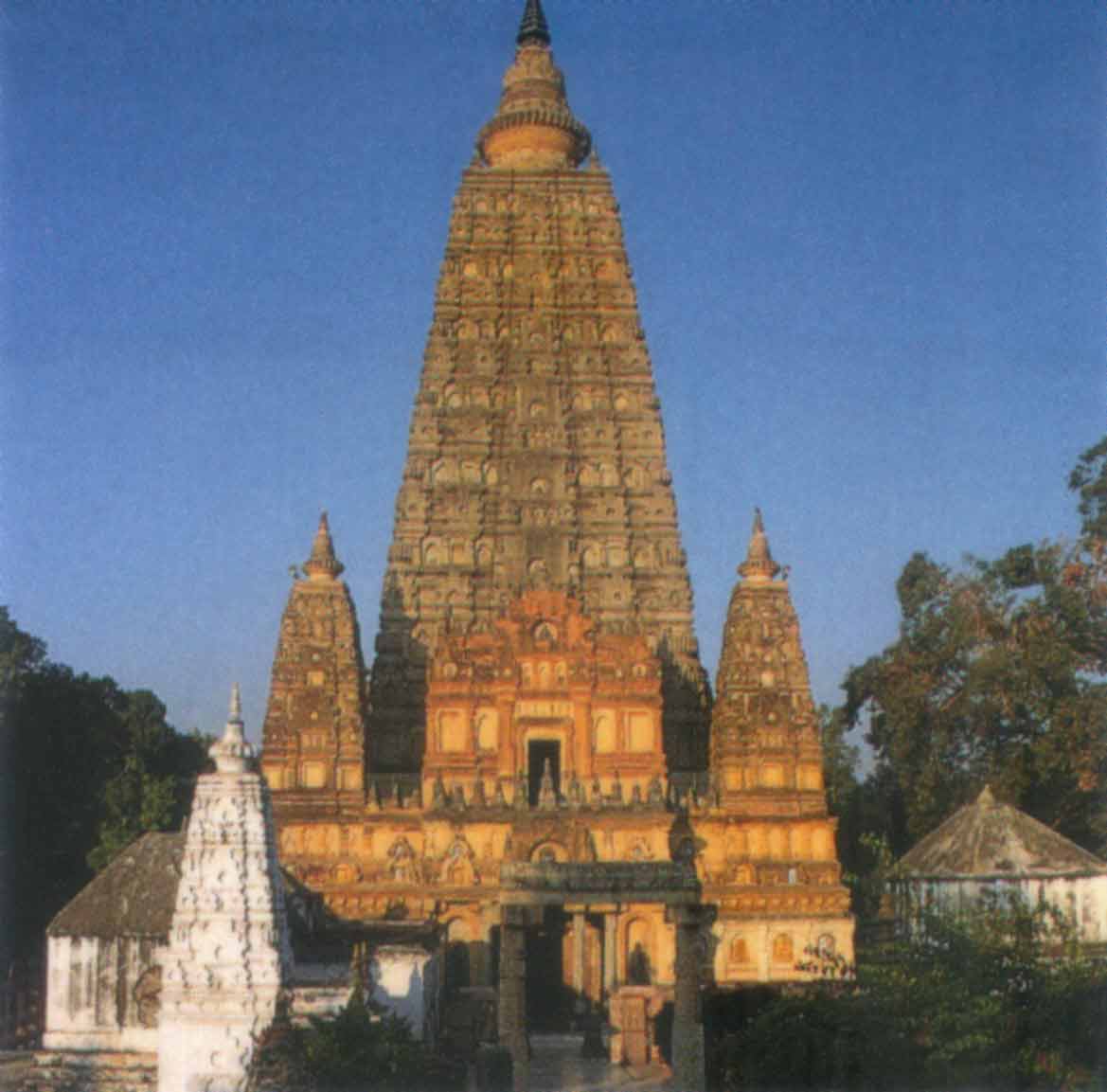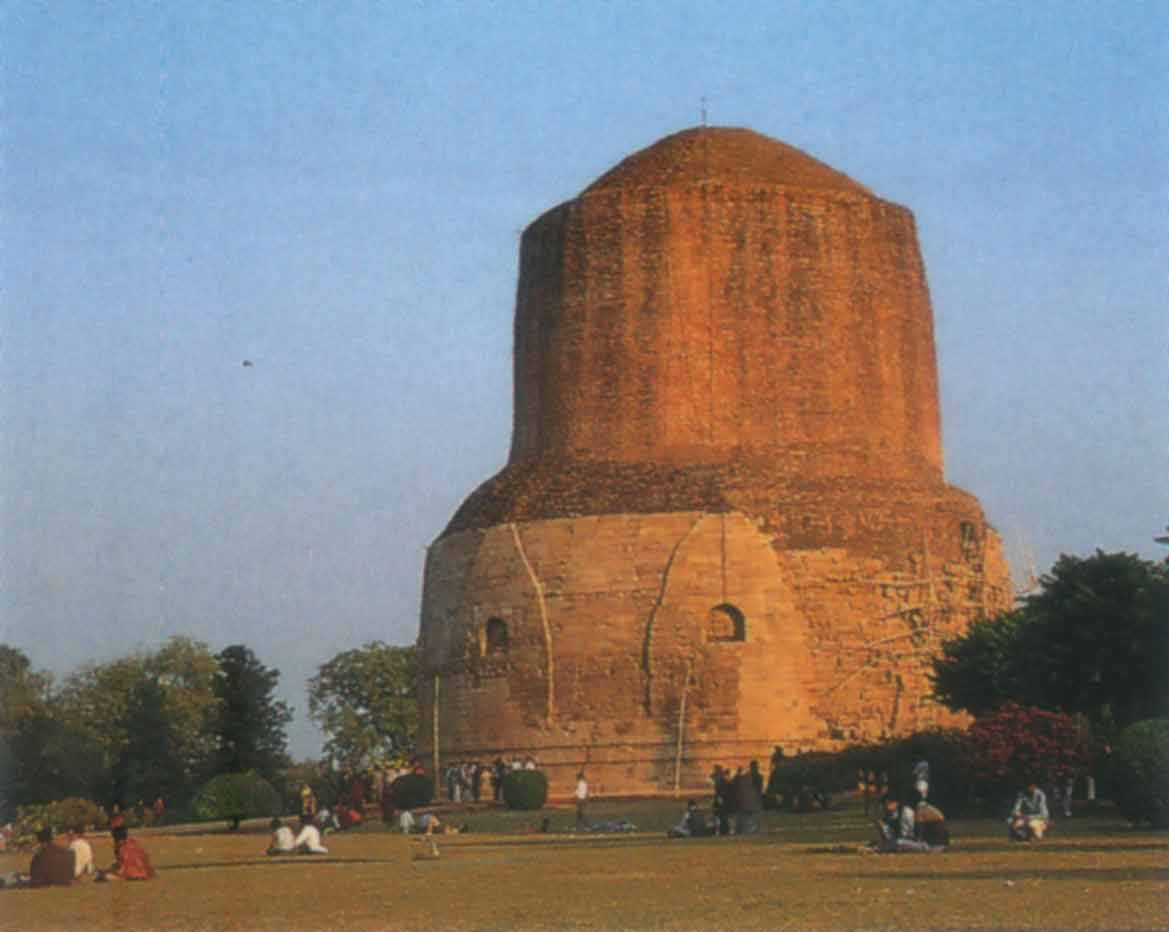|
| |
1. What is Buddhism?
2. The Buddha
3. The Dhamma
4. The Sangha
5. The Triple Gem
6. The Middle Path
7. Different Traditions of Buddhism
8. Dhamma or Dharma
9. Should Buddhists be vegetarians?
10. Bodhisattas - Who are they?
11. What are the significant sacred places in Buddhist history?
12. Preservation of Buddha's Teachings - The Buddhist Councils
13. Buddhist Calendar 
-
What is Buddhism?
Buddhism is widely understood to be the religion founded by the
Buddha, and originates from India. Apart from that, Buddhism can
also be viewed not solely as a religion, but also as a philosophy,
and even a way of life. The widely recognized founder of Buddhism,
the Buddha, actually has a name and was born a human being like any
one of us.
The word "Buddha" can be defined as "the Enlightened One",
or "the Awakened One".
-
The Buddha
The Buddha was born in 623 B.C. in a country called Kapilavatthu in
Northern India (its present site within Nepal's boundary). Born in
the noble Sakya clan, he was named Siddhattha Gotama. As a prince of
the country, he did not have to face the unsatisfactoriness and
sufferings encountered by the common folks. He married his cousin
Princess Yasodhara, who bore him a son by the name of Rahula. Life
was good and without worries.
However, things changed after Prince Siddhattha took a private visit
out of the palace and saw the four sights of Sickness, Old Age,
Death and a holy man. That prompted him to renounce his comfortable
life to seek out the truth in order to end the sufferings of common
people. At the age of 29, he left his palace quietly in search of
the truth. He had studied under ascetic teachers, and tried various
methods of self-mortification, but to no avail. He learnt later that
extremes (of indulgence versus torture) are not going to work out.
After searching for 6 years, one day, he sought shelter under a
tree, and through intense meditation that he finally attained
Enlightenment, and sees things as they really are. Henceforth, he is
known as the Buddha. The tree under which the Buddha gained
Enlightenment has since been known as the Bodhi Tree.
The story did not stop here. Out of his compassion for all beings,
he set off to expound the Truth (the Dhamma) that he had newly
realized. Gradually, a pool of disciples benefited from his
teachings after comprehending his teachings. The organization
of the Buddha's disciples had come to be known as the Sangha.
The Buddha and his disciples travelled vast areas (on foot)
throughout India to
expound the Dhamma, helping lots of suffering people along the way.
His relentless effort lasted for 45 years. The Buddha passed into
Parinibbana (or passed away in simplified layman's term) at the ripe
old age of 80.
-
The Dhamma
The Dhamma could simply mean the teachings of the Buddha. No doubt
there were many scriptures and expositions made by him, the most
concise essence of the Truth could be found in the Four Noble Truths
taught by the Buddha. For more details, please see the
Dhamma section.
-
The Sangha
The Sangha refers to the followship of disciples of the Buddha.
Generally, it includes the Buddhist monks and nuns, who had made
their commitments to lead a monastic way of life, and to carry on
and preserve the teachings and tradition left behind by the
Buddha. On a wider scope, Sangha includes the lay disciples.
-
The Triple Gem
Also termed the Three Refuges, the Triple Gem comprises of the Buddha, the
Dhamma, and the Sangha.
-
The Middle Path
As described above, in his quest for Enlightenment, the Buddha realized that
extreme measures of self-mortification weakens one physically and
intellectually, which impedes spiritual progress. Similarly, self-indulgence
would not contribute to progress. Middle Path is the way, which implies
moderation. This notion of Middle Path is still of very much practical use
even today.
-
Different Traditions of Buddhism
There exists today different Buddhist schools of thoughts. Why there are
different schools could be boiled down to two main reasons:-
-
In early Buddhist history, all sermons and teachings were spoken and
committed to memory. It was only later that scriptures were written
down on leaves and then paper. Variation in interpretation by
different people of the same principle could arise. Furthermore, it
was also highly possible that the Buddha gave a variety of teachings
to different people to suit individual aptitude, ability and
interest.
-
The different schools also reflect different cultural attributes,
which were influenced by the route where Buddhism propagated
geographically. E.g. The Theravada tradition spreaded south to Sri
Lanka, Myanmar, Thailand, Laos, etc.; the Mahayana tradition went
northwards to Vietnam, China, Japan, etc.
The Major Schools of Buddhism are:-
-
Theravada School (The Way of the Elders)
-
Mahayana School (The Great Vehicle)
-
Vajrayana School
Despite the differences in traditions, it must be stressed that
doctrinally there is absolutely no disagreement concerning the
Dhamma as contained in the sacred texts - Tipitaka.
Also, it must be emphasized that Buddhism teaches tolerance, and it
would be counter-productive to discriminate one tradition/sect
against another. In fact, there were wrongful reference of
Theravadin tradition as Hinayana (the lesser vehicle, in contrast
with the greater vehicle), which by itself is of derogatory
connotation and this misunderstood record should be set straight.
Diversity in tradition should not be the issue here - the
application of the Buddha's teachings for the common good of all
beings should be the key. What good does it do if one keep saying
that "I'm of abc tradition and is more superior than efg
tradition" per se? At the end of the day, it pays to
remember that the Buddha never taught a sectarian religion; he
taught Dhamma - the way to liberation - which is universal.
- Dhamma or Dharma?
Is there a spelling mistake? Why do some books spell the
Buddha's teachings as Dhamma, whereas
some spell as Dharma? Similarly, is it Kamma
or Karma? It should be understood that
both are correct spelling, and at times, the different formats are used
interchangeably. The words Dhamma, Kamma,
etc are in Pali language whereas Dharma,
Karma are in Sanskrit.
Both were languages used in India from olden times, though Pali language is
the closest and most original form of the language spoken during the
Buddha's time. Pali language is used by the Theravadin tradition, in both
the scriptures and suttas chanting. Sanskrit could be found extensively in
Mahayana texts.
Examples of Pali / (Sanskrit) comparison:-
Dhamma / (Dharma)
Kamma / (Karma)
Sutta / (Sutra)
Nibbana / (Nirvana)
Gotama / (Gautama)
- Should Buddhists be vegetarians?
It was the impression of many that a "true" Buddhist should not eat meat.
Certain Buddhist traditions (e.g. Mahayana, or Chinese Buddhism) actually
practise vegetarianism. The intention of vegetarianism is actually of a
noble one - out of compassion for all sentient beings, human beings should
try not to consume flesh of other animals. However, many Theravadin
tradition monastic orders do not impose strict vegetarianism; that is why it
can be observed that Thai monks for example, can eat meat (Note that many of these monks have to go on alms rounds every morning, and have to accept whatever food that is given by devotees). Many debates and
questions were raised on this issue. Now, should it be or not?
In the Samyutta Nikaya, the Buddha covered the topic on vegetarianism:-
"... I have declared that one should not make use of meat if it has
been seen, heard or suspected to have been killed on purpose for a monk. I
allow the monks meat that is quite pure in 3 respects: if it is not seen,
heard or suspected to have been killed on purpose for a monk."
Being a vegetarian alone does not necessary means a worthy cause; if one's action, speech
and thoughts are impure despite being a vegetarian, what good does it do?
The Buddha also made this point clear:-
"Taking life, beating, cutting, binding, stealing, lying, fraud,
deceit, pretence at knowledge, adultery; this is uncleanliness and not the
eating of flesh."
Of course, going to a seafood restaurant to order a fish will not be covered
under what the Buddha had said - you jolly well know that there are life
fishes swimming in the fish tanks, and when you place an order, one of the
fish is definitely going to be killed to be served to your table. You know
that. And that is intentional killing.
- Bodhisattas
Who is a Bodhisatta (or Bodhisattva in Sanskrit)?
The components of the term explains. Bodhi
refers to "enlightenment" and Satta
means "devoted to". As such, this term can generally be used to
refer to someone who is striving for enlightenment. In a focused sense, a
Bodhisatta is someone who will eventually become a Buddha.
The key characteristic of a Bodhisatta is that he/she wants the welfare
and good of all satient beings in the world. Compassion is one of the
great qualities embodied in him/her. Just as a mother who would protect
and provide for the well-being of her own child, a Bodhisatta, may in
certain cases sacrifice his own life in order to save others from misery.
A Bodhisatta is selfless.
A Bodhisatta in the course of helping others, practices the Perfections:-
-
Generosity
-
Morality
-
Renunciation
-
Wisdom
-
Energy
-
Patience
-
Truthfulness
-
Determination
-
Loving-kindness
-
Equanimity
One of the most well known Bodhisattva in the Mahayana tradition is Avalokitesvara
Bodhisattva, also known as Kuan Yin in
Chinese, and some people called him the Goddess of
Mercy. Note that I use "him" in the previous sentence.
For a cultivated state of mind which has achieved wisdom or enlightenment,
gender becomes not relevant anymore; it is a state of mind. The reason why
the Goddess of Mercy is called is that Avalokitesvara has in the past
known to manisfest in female form (e.g. a motherly manifestation, as can
be seen from drawings/portraits worldwide) in the course of saving satient
beings.
Lastly, it should be noted that Bodhisatta is not a 'proprietary' idea of
Buddhism. In a broad sense, we can find Bodhisattas around us in our daily
lives, e.g. those individuals full of energy to serve the elderly and the
sick. The late Mother Teresa is an example of a person who practiced the
Bodhisatta ideal.
- Significant
Sacred Places in Buddhist History
Birth Place of the Buddha - Lumbini Park

The mother of the then Prince Siddhattha, Queen Maha Maya gave birth at
Lumbini Park, on the Indian borders of Nepal. Why not in the palace? It
is known that the custom of that time was for the queen to return to her
maternal home to give birth, but things couldn't wait and the birth took
place during her journey mid-way.
Where the Buddha Gained Enlightenment -
Buddhagaya
After struggling for 6 years, the Buddha finally gained enlightenment by
his own effort, and sees things as they truly are. Buddhagaya marks the
location where this took place more than 2,500 years ago.
Deer Park - Hear The Buddha's First Lecture

The Buddha delivered his first discourse - the Dhammacakkappavattana
Sutta after his enlightenment. It was not at a lecture hall, but at the
beautiful deer park at Sarnath.
The Buddha's Last Stop - Kusinara
The Buddha attained Parinibbana (or passed away in laymen's language) at
80 years old, after 45 years of tireless years of travelling and
preaching the doctrine. This took place at Kusinara.
The rights of the original photographer's work are asserted. It's
through these beautiful pictures that we once again feel close to the
Buddha, who although left more than 2,500 years ago, but his teachings
are always there to guide and inspire.
- The Buddhist
Councils
As you would have guessed, the primary aim of a Buddhist Council was to
preserve and safeguard the originality of the Buddha's teachings.
It all started this way: It was understood that after the Buddha passed
away, some not so righteous members of the Sangha then were happy that the
Buddha was not there to oversee their conduct anymore, and they thought that they
were free to do what they wanted. Alarmed by such behaviours and the
possibility for heretic views to grow, the major disciples congregated
together for a convention. Apart from stomping out any unrighteous elements of the Order,
the most important activities performed were the recital and reaffirmation
of the major teachings passed down by the Buddha, including the code of
conduct for the Sangha, the discourses given by the Buddha, and the higher
teachings. All these compilation were later known as the Tipitaka. This
was the initial effort to preserve Buddhism, till it passes down to the
present day.
The 1st Buddhist Council took place 3 months after the passing away of the Buddha.
The other two major councils took place after 100 and more than 200 years
later,
respectively.
- Buddhist Calendar
Have you ever come across some calendar referencing current year as something
like 2540? There's nothing puzzling about it, as it refers to the Buddhist
Calendar
As you may know, the Buddha was born in 623 B.C. and passed away at the age of
80 years old, which was year 543 B.C. The Buddhist Calendar starts its reference
point from here. Hence, year 2003 would translate to (2003 + 543) = year 2546.
You can see the usage of Buddhist Calendar in Buddhist countries such as Thailand.
 Back to Top
Back to Top
 Home |
What's in Buddhism | Dhamma
| Montage
| Profile and Links
Home |
What's in Buddhism | Dhamma
| Montage
| Profile and Links 
|